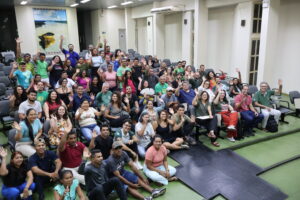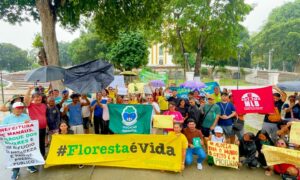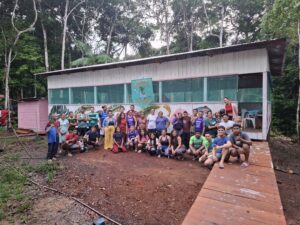Instituto Juruá supported an expedition to inventory the fauna and flora in the Mid-Juruá, with the participation of 24 researchers specializing in different taxonomic groups.
By Pilar Maia, Emanuelly Félix e Joseph Hawes
ABC aims to revisit the locations of some of the original plots from the RadamBrasil project, a Brazilian government initiative from the 1970s that mapped the natural resources of the Amazon through more than three thousand 1-hectare plots. Our current sampling will provide multi-taxa biodiversity surveys and estimates of forest structure and carbon stocks in some of the least sampled regions across the Brazilian Amazon. With these results, it will also be possible to assess the effects of more than 50 years of environmental degradation, and to make predictions for future trends.
In each area inventoried by ABC, three 1-ha plots are selected where we measure vegetation structure and sample multiple taxonomic groups: plants, birds, animals, amphibians, reptiles, termites, ants, dung beetles, flies, bees and other insects. In addition to a multidisciplinary team, ABC has a partnership with research institutions across Brazil: National Institute of Amazonian Research (INPA), Federal University of Amazonas (UFAM), Emílio Goeldi Museum, Mato Grosso State University (UNEMAT), Federal University of Mato Grosso (UFMT), Federal University of Paraiba (UFPB), Federal University of Santa Catarina (UFSC) and Federal University of Santa Maria (UFSM). These institutions provide essential expertise, and the project in turn supports the training and career development of Brazilian students.
The ABC expeditions project has been underway since 2019, and to date has carried out seven field expeditions across the Amazon. In June and July of this year, with the support of Instituto Juruá, we carried out two expeditions – each lasting approximately 18 days – on either margin of the Juruá River. The first one took place on the left bank of the river, at Lago Surara. The ABC team made an initial presentation of the project and explained the work to be carried out at a community meeting in the village of São João. Instituto Juruá provided all logistical support for the expedition and its new base as accommodation for our researchers, as well as acting as an intermediary in hiring research assistants from various local communities, in a partnership with AMAB – Associação de Moradores Agroextrativistas do Médio Juruá.


Técnico do Instituto Juruá, Edimar Costa, realizando coleta de cupins. (Foto: Emanuelly Félix).
The second expedition took place on the right bank of the Juruá River, near the community of Marizal. This time, the team stayed in several unoccupied houses, provided by the community themselves. Research assistants were hired directly from the community and trained to carry out the work. At the end of the fieldwork, the ABC team organized another presentation for the entire community, showing some of the main results found and some examples of the local fauna and flora.
Over almost two months, across the two expeditions, about 40 local community residents assisted the research activities of the ABC team, including the installation and checking of traps for insects, mammals, reptiles, and amphibians, as well as mist-net captures of birds, the collection of botanical specimens, and carrying out active searches for various groups, such as mammals, termites and nocturnal herpetofauna. It is very important to emphasize that, in addition to all the scientific work carried out with the riverside communities of Juruá, the ABC team had a unique opportunity to interact with the community, learning local customs and exchanging knowledge. The receptivity, enthusiasm and interest of the community were essential in carrying out all our work, and we hope the technical knowledge acquired by them can be used to support future research carried out in Juruá.
From all of us in the ABC team, our thanks to Instituto Juruá and everyone in the communities for your support!






